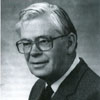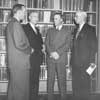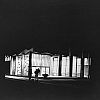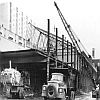The Bruce Peel Era, Act I: Years of Explosive Growth, 1955–1970

Bruce Braden Peel (1916–1998) was born and raised on a prairie farm near Ferland, Saskatchewan. After teaching in rural Saskatchewan and war service in Ontario, he studied history at the University of Saskatchewan (BA, MA) and earned a library degree at the University of Toronto. After five years working in the University of Saskatchewan Library, he joined the University Library as Chief Cataloguer in 1951. By 1955, the year of Peel’s appointment as Librarian to the University, the Library had almost 160,000 volumes, subscriptions to over 1600 periodicals, a regular staff of 30, and 50 part-time student assistants. Scholastic activity was increasing at a dizzying rate, as total student enrollments tripled between 1957 and 1970. The steady growth, particularly of graduate students, required that the Library increase acquisitions well beyond the requirements of undergraduate programs.

This rate of growth overtaxed the Library’s study space of 900 reading room seats and 70 study carrels in the stack tiers, and prompted serious consideration of further library expansion. In the fall of 1956, the Library Committee held a series of seven meetings to study the Library’s space needs for the next decade. The subsequent report predicted that in ten years the Library’s collection would increase by at least 100,000 volumes and student enrollment rise to 6,500. In fact, these numbers were achieved in five years. A modest addition to Rutherford Library was proposed. Meanwhile, some space relief was achieved through transferring some collections elsewhere on campus, something the new building was originally designed to end. The proposed “modest addition” was firmly rejected in 1959 by Vice-President L.H. Cragg, who urged immediate planning for a more major expansion, for not only had the Library’s holdings doubled over the preceding decade to 200,000 volumes, but the burgeoning rate of acquisition had pushed the ordering of books to an average of 2,500 a month, so that the Library anticipated receiving a minimum of 22,000 volumes that year.

The Library Committee secured the consulting services of the leading authority on academic library design, Dr Keyes D. Metcalf. His hard-headed cost-benefit analysis persuaded the Board of Governors to accept his vision for a new building. The following year, on February 3, 1961, while the University awaited approval and funding for the proposed new building, The Gateway reported that the Library anticipated receiving almost 30,000 books during 1961, and that an additional 1,000 students were expected to matriculate in the next academic year. As if to reinforce in the public mind the pressing need for more library space, at the end of 1961 Peel took the then-drastic step of closing the Library’s smoking rooms to secure more storage space. The alternative was to stop ordering books. Excavation for the new $2,500,000 library, designed to hold 550,000 volumes and named in honour of Donald Ewing Cameron, began at last in August 1962, construction was completed in September of the following year, and by the third week in November 1963, the building was ready for occupancy. The moving of offices and 343,500 books was completed on December 9, and on May 28, 1964, Cameron Library was officially opened. Reactions to the new building, designed by D.L.G. MacDonald and W. Wood, were highly mixed. Another example of a purely functional structure was completed at about the same time; the new Education Library opened as part of a large, new education complex in fall term, 1963. While austerely modern in design, it failed to elicit much comment or criticism, perhaps because Cameron Library was too tempting a target. In 1968, a third floor was added, that provided the Education Library with an additional 14,000 square feet of space, and in 1979 the building was named for Herbert T. Coutts, the previous Dean of Education.

Cameron Library was designated for graduate research collections, while Rutherford Library housed the undergraduate and reserve collections, as well as the Law and Extension Libraries, which set the University Library on the road to further decentralization. In 1965, the Library also took over the staffing and operation of the John W. Scott Library in the University Hospital. As student enrollment and book acquisitions continued to increase, space in the new Cameron Library reached a critical stage within two years, rendering more imperative the planned doubling of the building by adding two wings. In addition to accommodating an anticipated 100,000 new volumes, the Library was recruiting staff to fill 30 to 40 new positions for which working space would be required. Completed in November 1969, the new North Wing added 47,500 square feet of space. Despite a pleasant surprise when the project came in under budget, other budget shortfalls and protests prevented the planned building of the other wing.
With all this growth, some administrative changes were required. Cameron Library’s open-stacks plan required staffing of a bag-check station at the exit to ensure that all books were properly charged out at the Circulation Desk. Students were also issued library identity cards for the first time, and the traditional honour system of not imposing fines on students for overdue books, other than those placed on reserve, was ended, albeit reluctantly. Open stacks also meant that older and more valuable books had to be identified and segregated from the main collection. The Library’s holdings of rare books, many already kept under lock and key, were thus considerably augmented and moved into a Rare Book Room established in January 1964. A separate Government Documents Section was also created.
Perhaps the greatest challenge Peel and his colleagues confronted during this era of unprecedented growth was recruiting and training new staff. The increases in student enrollment, faculty positions, and library collections coincided with a booming economy, which meant private-sector employers offered salaries and wages that the University was at pains to match. During the 1960s, expansion of post-secondary education in Canada also led to demand for experienced academic librarians which prompted a great turnover rate among those working at the University. Peel pressed for creation of a library school at the University to provide a supply of locally-trained professionals. In May 1965, the Board of Governors authorized creation of a one-year Bachelor of Library Science program, and in January 1967, Ms Sarah Rebecca Reed was appointed its first director. The first students entered the program in autumn of 1968. Meanwhile, the Library resorted to advertising abroad for librarians. In December 1966, Peel flew to London, where he met and interviewed three dozen applicants who had responded to these advertisements. One of the applicants was Mr L.E.S. Gutteridge, a veteran of the British antiquarian book trade, who persuaded Peel to establish a unit within the Library to pursue out-of-print titles.
In his 1966–1967 report, Peel noted that 11 librarians had been hired, but nine others decamped. The following year’s tally was somewhat better: 15 were appointed and only 4 departed. The results for 1968–1969 were less successful, with 15 librarians appointed, while 11 left. In 1969, the year the first class of locally trained librarians graduated, the Library filled 26 positions, thus increasing the professional staff by 50 percent. The greatest need was for cataloguers. Moreover, as the Library collections grew more cosmopolitan, multilingual librarians were especially in demand. By 1968, staff linguistic skills embraced a total of twenty-nine languages. The total staff grew from 83 in 1963–1964 to a high of 390 in 1970–1971.
In 1965, the Library Committee issued Library Requirements in the Decade Ahead, which recommended that by 1976 the Library’s collection should grow to 3 million volumes (exclusive of government documents and microforms). Achieving this goal, which would require an acquisitions rate of perhaps 350,000 volumes a year, or 1500 per working day, raised scepticism among some, including the Chief Librarian, who nonetheless presented the Administration with a space-needs plan that envisioned 9 million volumes by 1999. Also in 1965, Library expenditures on books and other information resources exceeded $500,000, a far cry from the $35,000 Peel had at his disposal during his first year in charge. During that same time, annual accessions grew from an average of 9,000 volumes to almost 60,000. In 1969, the University of Alberta Library was invited to join the elite ranks of the Association of Research Libraries, whose seventy members represented the largest research libraries in North America. On May 26, 1970, only four years after acquiring the half-millionth volume, the Library collection had doubled again, and the one-millionth volume was added. For this milestone occasion, the title selected to be thus designated was Notes of a Sporting Expedition in the Far West of Canada, 1847 by Sir Frederick Ulric Graham (London: s.n., 1898), one of a privately printed edition limited to 22 copies.